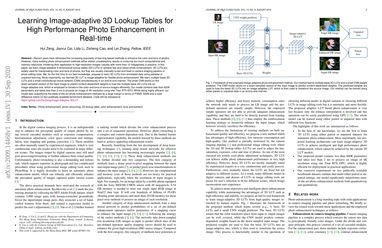Learning Image-adaptive 3D Lookup Tables for High Performance Photo Enhancement in Real-time
Recent years have witnessed the increasing popularity of learning based methods to enhance the color and tone of photos. However, many existing photo enhancement methods either deliver unsatisfactory results or consume too much computational and memory resources, hindering their application to high-resolution images (usually with more than 12 megapixels) in practice. In this paper, we learn image-adaptive 3-dimensional lookup tables (3D LUTs) to achieve fast and robust photo enhancement. 3D LUTs are widely used for manipulating color and tone of photos, but they are usually manually tuned and fixed in camera imaging pipeline or photo editing tools. We, for the first time to our best knowledge, propose to learn 3D LUTs from annotated data using pairwise or unpaired learning. More importantly, our learned 3D LUT is image-adaptive for flexible photo enhancement. We learn multiple basis 3D LUTs and a small convolutional neural network (CNN) simultaneously in an end-to-end manner. The small CNN works on the down-sampled version of the input image to predict content-dependent weights to fuse the multiple basis 3D LUTs into an image-adaptive one, which is employed to transform the color and tone of source images efficiently. Our model contains less than 600K parameters and takes less than 2 ms to process an image of 4K resolution using one Titan RTX GPU. While being highly efficient, our model also outperforms the state-of-the-art photo enhancement methods by a large margin in terms of PSNR, SSIM and a color difference metric on two publically available benchmark datasets.
PDF AbstractDatasets
Results from the Paper
 Ranked #5 on
Image Enhancement
on MIT-Adobe 5k
(SSIM on proRGB metric)
Ranked #5 on
Image Enhancement
on MIT-Adobe 5k
(SSIM on proRGB metric)




 MIT-Adobe FiveK
MIT-Adobe FiveK